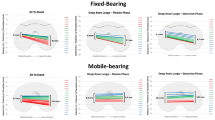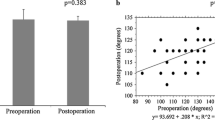Abstract
Purpose
The purpose of this study was to compare two types of posterior-stabilized (PS) mobile-bearing (MB) total knee arthroplasties (TKAs). The hypothesis was that no major differences were going to be found among the two TKA designs.
Methods
Two cohorts of patients who were divided according to implant design (Cohort A, new design gradually reducing radius PS MB TKA; Cohort B, traditional dual-radius PS MB TKA) were analyzed by means of intraoperative navigation. All operations were guided by a non-image-based navigation system that recorded relative femoral and tibial positions in native and implanted knees during the following kinematic tests: passive range of motion (PROM), varus–valgus stress test at 0° and 30° (VV0, VV30) and anterior/posterior drawer test at 90° of flexion (AP90).
Results
There were no significative differences in kinematic tests between the two implants. Cohort A, however, showed a different post-implant trend for VV0 and VV30 that were lower than the pre-implant ones, as expected, while for Cohort B, the trend is opposite. However, the gradually reducing radius prosthesis (Cohort A) showed a trend of improving stability (29% compared to the preoperative status) in mid-flexion (VV30) which the traditional dual-radius design (Cohort B) would not. Moreover, we found no differences among postoperative results of the two TKA designs.
Conclusion
Despite design variations, no difference has been found among the prostheses in terms of PROM, rotations and translations. Both design kinematics did not show paradoxical external rotations, but an increase in femoral translation in mid-flexion without affecting the functioning of the prosthesis.
Level of evidence
II.







Similar content being viewed by others
References
Baier C, Springorum HR, Götz J, Schaumburger J, Lüring C, Grifka J, Beckmann J (2013) Comparing navigation-based in vivo knee kinematics pre- and postoperatively between a cruciate-retaining and a cruciate-substituting implant. Int Orthop 37:407–414
Bignozzi S, Lopomo N, Martelli S, Bruni D, Marcacci M (2008) Accuracy, reliability, and repeatability of navigation systems in clinical practice. Oper Techn Orthop 18:154–157
Bignozzi S, Zaffagnini S, Akkawi I, Marko T, Bruni D, Neri MP, Colle F, Marcacci M (2014) Three different cruciate-sacrificing TKA designs: minor intraoperative kinematic differences and negligible clinical differences. Knee Surg Sports Traumatol Arthrosc 22:3113–3120
Bontempi M, Cardinale U, Bragonzoni L, Macchiarola L, Grassi A, Signorelli C, Marcheggiani Muccioli GM, Zaffagnini S (2017) Total knee replacement: intraoperative and postoperative kinematic assessment. Acta Biomedica 88:32–37
Capella M, Dolfin M, Saccia F (2016) Mobile bearing and fixed bearing total knee arthroplasty. Ann Transl Med 4:127
Carey BW, Harty J (2018) A comparison of clinical- and patient-reported outcomes of the cemented ATTUNE and PFC sigma fixed bearing cruciate sacrificing knee systems in patients who underwent total knee replacement with both prostheses in opposite knees. J Orthop Surg Res 13:54
Casino D, Zaffagnini S, Martelli S, Lopomo N, Bignozzi S, Iacono F, Russo A, Marcacci M (2009) Intraoperative evaluation of total knee replacement: kinematic assessment with a navigation system. Knee Surg Sports Traumatol Arthrosc 17:369
Clarke JV, Deakin AH, Picard F, Riches PE (2017) Lower limb alignment and laxity measures before, during and after total knee arthroplasty: a prospective cohort study. Clin Biomech 47:61–65
Clary CW, Fitzpatrick CK, Maletsky LP, Rullkoetter PJ (2013) The influence of total knee arthroplasty geometry on mid-flexion stability: an experimental and finite element study. J Biomech 46:1351–1357
Dennis DA, Komistek RD, Colwell CE, Ranawat CS, Scott RD, Thornhill TS, Lapp MA (1998) In vivo anteroposterior femorotibial translation of total knee arthroplasty: a multicenter analysis. Clin Orthop Relat Res 356:47–57
Ethgen O, Bruyere O, Richy F, Dardennes C, Reginster J-Y (2004) Health-related quality of life in total hip and total knee arthroplasty. J Bone Joint Surg 86:963–974
Fantozzi S, Catani F, Ensini A, Leardini A, Giannini S (2006) Femoral rollback of cruciate-retaining and posterior-stabilized total knee replacements: in vivo fluoroscopic analysis during activities of daily living. J Orthop Res 24:2222–2229
Fitzpatrick CK, Clary CW, Rullkoetter PJ (2012) The role of patient, surgical, and implant design variation in total knee replacement performance. J Biomech 45:2092–2102
Fritzsche H, Beyer F, Postler A, Lützner J (2017) Different intraoperative kinematics, stability, and range of motion between cruciate-substituting ultracongruent and posterior-stabilized total knee arthroplasty. Knee Surg Sports Traumatol Arthrosc 26:1–6
Grood ES, Suntay WJ (1983) A joint coordinate system for the clinical description of three-dimensional motions: application to the knee. J Biomech Eng 105:136
Hino K, Kutsuna T, Watamori K, Ishimaru Y, Kiyomatsu H, Shiraishi Y, Miura H (2018) Bi-cruciate substituting total knee arthroplasty provides varus–valgus stability throughout the midflexion range. Knee 25:897–902
Huang C-H, Liau J-J, Cheng C-K (2007) Fixed or mobile-bearing total knee arthroplasty. J Orthop Surg Res 2:1
Indelli PF, Marcucci M, Pipino G, Charlton S, Carulli C, Innocenti M (2014) The effects of femoral component design on the patello-femoral joint in a PS total knee arthroplasty. Arch Orthop Trauma Surg 134:59–64
Kremers MH, Larson DR, Crowson CS, Kremers WK, Washington RE, Steiner CA, Jiranek WA, Berry DJ (2015) Prevalence of total hip and knee replacement in the United States. J Bone Joint Surg 97:1386–1397
Li G, Most E, Otterberg E, Sabbag K, Zayontz S, Johnson T, Rubash H (2002) Biomechanics of posterior-substituting total knee arthroplasty: an in vitro study. Clin Orthop Relat Res 404:214–225
Martelli S, Zaffagnini S, Bignozzi S, Bontempi M, Marcacci M (2006) Validation of a new protocol for computer-assisted evaluation of kinematics of double-bundle ACL reconstruction. Clin Biomech 21:279–287
Nemes S, Rolfson O, W-Dahl A, Garellick G, Sundberg M, Kärrholm J, Robertsson O (2015) Historical view and future demand for knee arthroplasty in Sweden. Acta Orthop 86:426–431
Ranawat CS, Komistek RD, Rodriguez JA, Dennis DA, Anderle M (2004) In vivo kinematics for fixed and mobile-bearing posterior stabilized knee prostheses. Clin Orthop Relat Res 418:184–190
Ranawat CS, White PB, West S, Ranawat AS (2017) Clinical and radiographic results of attune and PFC sigma knee designs at 2-year follow-up: a prospective matched-pair analysis. J Arthroplas 32:431–436
Singh JA (2011) Epidemiology of knee and hip arthroplasty: a systematic review. Open Orthop J 5:80–85
Siston RA, Giori NJ, Goodman SB, Delp SL (2006) Intraoperative passive kinematics of osteoarthritic knees before and after total knee arthroplasty. J Orthop Res 24:1607–1614
Tjørnild M, Søballe K, Hansen PM, Holm C, Stilling M (2015) Mobile- vs. fixed-bearing total knee replacement. Acta Orthop 86:208–214
Ünkar EA, Öztürkmen Y, Şükür E, Çarkçi E, Mert M (2017) Posterior cruciate-retaining versus posterior-stabilized total knee arthroplasty for osteoarthritis with severe varus deformity. Acta Orthop Traumatol Turcica 51:95–99
Young KL, Dunbar MJ, Richardson G, Wilson JLA (2015) Intraoperative passive knee kinematics during total knee arthroplasty surgery. J Orthop Res 33:1611–1619
Funding
The authors declare that they did not receive and will not receive any benefits or funding from any commercial party related directly or indirectly to the subjects of this article.
Author information
Authors and Affiliations
Corresponding author
Ethics declarations
Conflict of interest
The authors declare that they have no conflict of interest.
Ethical approval
All procedures performed in studies involving human participants were in accordance with the ethical standards of the institutional and/or national research committee and with the 1964 Helsinki Declaration and its later amendments or comparable ethical standards.
Informed consent
Informed consent was obtained from all individual participants included in the study.
Additional information
Publisher's Note
Springer Nature remains neutral with regard to jurisdictional claims in published maps and institutional affiliations.
Rights and permissions
About this article
Cite this article
Marcheggiani Muccioli, G.M., Fratini, S., Roberti Di Sarsina, T. et al. Two different posterior-stabilized mobile-bearing TKA designs: navigator evaluation of intraoperative kinematic differences. Musculoskelet Surg 105, 173–181 (2021). https://doi.org/10.1007/s12306-020-00643-1
Received:
Accepted:
Published:
Issue Date:
DOI: https://doi.org/10.1007/s12306-020-00643-1




